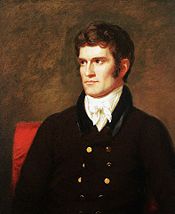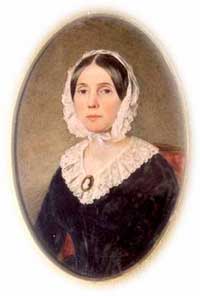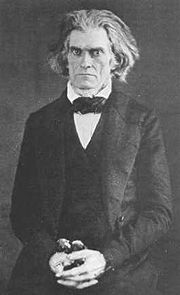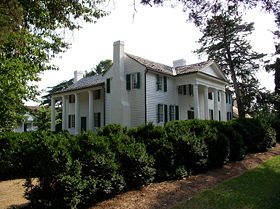Calhoun, John C.
(imported article and wiki version credit) |
Rosie Tanabe (talk | contribs) |
||
| (21 intermediate revisions by 11 users not shown) | |||
| Line 1: | Line 1: | ||
| + | {{Ebapproved}}{{Paid}}{{approved}}{{Images OK}}{{Submitted}}{{copyedited}} | ||
| + | {{epname|Calhoun, John C.}} | ||
| + | |||
{{Infobox_Vice_President | {{Infobox_Vice_President | ||
| name=John C. Calhoun | | name=John C. Calhoun | ||
| Line 4: | Line 7: | ||
| nationality=american | | nationality=american | ||
| order=7th [[Vice President of the United States]] | | order=7th [[Vice President of the United States]] | ||
| − | | term_start= | + | | term_start=March 4, 1825 |
| − | | term_end= | + | | term_end=December 28, 1832 |
| predecessor=[[Daniel D. Tompkins]] | | predecessor=[[Daniel D. Tompkins]] | ||
| successor=[[Martin Van Buren]] | | successor=[[Martin Van Buren]] | ||
| − | | birth_date= | + | | birth_date=March 18, 1782 |
| birth_place=[[Abbeville, South Carolina]] | | birth_place=[[Abbeville, South Carolina]] | ||
| − | | death_date= | + | | death_date=March 31, 1850 |
| death_place=[[Washington, D.C.]] | | death_place=[[Washington, D.C.]] | ||
| − | | spouse= | + | | spouse=Floride Bonneau Calhoun |
| religion=[[Unitarian|Unitarian]] | | religion=[[Unitarian|Unitarian]] | ||
| party=[[Democratic-Republican Party (United States)|Democratic-Republican]], [[Democratic Party (United States)|Democratic]], [[Nullifier Party|Nullifier]] | | party=[[Democratic-Republican Party (United States)|Democratic-Republican]], [[Democratic Party (United States)|Democratic]], [[Nullifier Party|Nullifier]] | ||
| order2=16th [[United States Secretary of State]] | | order2=16th [[United States Secretary of State]] | ||
| − | | term_start2= | + | | term_start2=April 1, 1844 |
| − | | term_end2= | + | | term_end2=March 10, 1845 |
| president2=[[John Tyler]] | | president2=[[John Tyler]] | ||
| predecessor2=[[Abel P. Upshur]] | | predecessor2=[[Abel P. Upshur]] | ||
| successor2=[[James Buchanan]] | | successor2=[[James Buchanan]] | ||
| order3=10th [[United States Secretary of War]] | | order3=10th [[United States Secretary of War]] | ||
| − | | term_start3= | + | | term_start3=October 8, 1817 |
| − | | term_end3= | + | | term_end3=March 4, 1825 |
| president3=[[James Monroe]] | | president3=[[James Monroe]] | ||
| predecessor3=[[William H. Crawford]] | | predecessor3=[[William H. Crawford]] | ||
| successor3=[[James Barbour]] | | successor3=[[James Barbour]] | ||
| − | | president=[[John Quincy Adams]]<br>[[Andrew Jackson]] | + | | president=[[John Quincy Adams]]<br/>[[Andrew Jackson]] |
}} | }} | ||
| − | '''John Caldwell Calhoun''' ( | + | '''John Caldwell Calhoun''' (March 18, 1782 – March 31, 1850) was a leading [[United States]] senator, vice president, and political philosopher from [[South Carolina]] during the first half of the nineteenth century. Calhoun was an influential spokesman for [[slavery]], [[Nullification Crisis|nullification]], and the rights of electoral minorities, such as slave-holders. His ideas helped lead to the [[American Civil War]] a decade after his death. |
| − | |||
| − | |||
| − | Calhoun | + | Calhoun began his career as a staunch nationalist, favoring war with Britain in 1812 and a vast program of internal improvements afterwards. He reversed course in the 1820s to attack nationalism in favor of [[states rights]] of the sort [[Thomas Jefferson]] had propounded in 1798. Although he died before the Civil War broke out, Calhoun was a major inspiration to the secessionists who created the short-lived [[Confederate States of America]]. Nicknamed the "cast-steel man" for his staunch determination to defend the causes in which he believed, Calhoun pushed the theory of nullification, an argument that states could declare null and void any federal law they deemed to be unconstitutional. He was an outspoken proponent of the institution of slavery, which he defended as a "positive good" rather than as a necessary evil. His rhetorical defense of slavery was partially responsible for escalating Southern threats of secession in the face of mounting abolitionist sentiment in the North. |
| + | {{toc}} | ||
| + | Although best known as a defender of slavery and a Southern partisan, Calhoun was among the nation's most important political theorists. His ''Disquisition on Government'' (1849) examined basic principles of sovereignty and personal liberty in the model of [[Aristotle]]'s ''Politics'' or [[Montesquieu]]'s ''Spirit of the Laws''. It remains one of the most trenchant defenses of limited government and minority interests, while, ironically, providing philosophical justification for the denial of rights of Southern slaves. | ||
==Early life== | ==Early life== | ||
| − | John Calhoun was the son of [[Scots- | + | [[Image:JCCalhoun-1822.jpg|thumb|left|175px|An 1822 portrait of John C. Calhoun]] |
| − | + | John Calhoun was the son of [[Scotland|Scots]]-[[Ireland|Irish]] American immigrant Patrick Calhoun. When his father became ill, the 14-year-old boy quit school to manage the family farm in [[South Carolina]]. But he eventually returned to his studies, earning a degree from [[Yale University|Yale College]] in 1804. After studying law at the Tapping Reeve Law School in Litchfield, [[Connecticut]], Calhoun was admitted to the South Carolina bar in 1807. | |
| − | |||
| − | + | In January 1811, Calhoun married his first-cousin-once-removed, Floride Bonneau Colhoun. The couple had ten children over an 18-year period, although three died in infancy. During her husband's second term as Vice President, Floride Calhoun was a central figure in the [[Petticoat Affair]]. | |
==Early political career== | ==Early political career== | ||
| − | In 1810, Calhoun was elected to Congress, and became one of the [[War Hawk]]s who, led by [[Henry Clay]], agitated for what became the [[War of 1812]]. After the war, he led a [[Bonus Bill]] for [[public works]]. With the goal of building a strong nation that could fight a future war, he aggressively pushed for high protective tariffs (to build up industry), a national bank, internal improvements, and many other policies he later repudiated. | + | In 1810, Calhoun was elected to Congress, and became one of the [[War Hawk]]s who, led by [[Henry Clay]], agitated for what became the [[War of 1812]]. After the war, he led a [[Bonus Bill]] for [[public works]]. With the goal of building a strong nation that could fight a future war, he aggressively pushed for high protective tariffs (to build up industry), a national bank, internal improvements, and many other policies he later repudiated. |
| − | In 1817, President [[James Monroe]] appointed Calhoun to be [[United States Secretary of War|Secretary of War]], where he served until 1825 | + | In 1817, President [[James Monroe]] appointed Calhoun to be [[United States Secretary of War|Secretary of War]], where he served until 1825. His opponents were the "Old Republicans" in Congress, with their Jeffersonian ideology for economy in the federal government; they often attacked the operations and finances of the war department. Calhoun was a reform-minded executive, who attempted to institute centralization and efficiency in the Indian department, but Congress either failed to respond to his reforms or rejected them. Calhoun's frustration with congressional inaction, political rivalries, and ideological differences that dominated the late early republic spurred him to unilaterally create the [[Bureau of Indian Affairs in 1824]]. |
==Vice Presidency== | ==Vice Presidency== | ||
| − | + | Calhoun originally was a candidate for President in the election of 1824, but decided to become the running mate to both [[John Quincy Adams]] and [[Andrew Jackson]]. Thus while no candidate received a majority in the [[Electoral College]] and the election was ultimately resolved by the House of Representatives, Calhoun was elected [[Vice President of the United States|Vice President]] in a landslide. | |
| − | Calhoun originally was a candidate for President in the | + | |
| + | As his election was separate from that of [[John Quincy Adams|Adams]], who he believed unfairly favored Northern interests, he was not considered part of the administration and the two feuded frequently. In 1828, he ran for reelection as the running mate of [[Andrew Jackson]], and thus became only the second Vice President to serve under two presidents—George Clinton was vice president during the administrations of [[Thomas Jefferson]] and [[James Madison]]. | ||
| + | |||
| + | [[Image:Floride Calhoun nee Colhoun.jpg|thumb|right|210px|His wife, Floride Calhoun]] | ||
| + | Under [[Andrew Jackson]], Calhoun's vice presidency remained controversial. As with Adams, a rift between Northern and Southern views drove a wedge between Calhoun and his president. | ||
| − | + | The [[Tariff of 1828]], also known as the [[Tariff of Abominations]] aggravated the rift between Calhoun and the Jacksonians. He had been assured that Jacksonians would reject the bill, but the Northern Jacksonians were primarily responsible for its passage. Frustrated, he returned to his South Carolina plantation to write ''[[South Carolina Exposition and Protest]],'' an essay rejecting the nationalist philosophy he once advocated. | |
| − | |||
| − | === | + | === Nullification === |
| − | |||
| − | |||
| − | |||
| − | He now supported the theory of [[concurrent majority]] through the doctrine of nullification — that individual states could override federal legislation they deemed unconstitutional. Nullification traced back to arguments by [[Thomas Jefferson]] and [[James Madison]] in writing the [[Kentucky and Virginia Resolutions]] of 1798, which proposed that states could nullify the [[Alien and Sedition Acts]]. Jackson, who supported states rights, but believed that nullification threatened the union, opposed it. The difference, however, between Calhoun's arguments and those of Jefferson and Madison, is that Calhoun explicitly argued for the state's right to secede from the Union if necessary, instead of simply nullifying certain federal legislation. | + | He now supported the theory of [[concurrent majority]] through the doctrine of nullification—that individual states could override federal legislation they deemed unconstitutional. Nullification traced back to arguments by [[Thomas Jefferson]] and [[James Madison]] in writing the [[Kentucky and Virginia Resolutions]] of 1798, which proposed that states could nullify the [[Alien and Sedition Acts]]. Jackson, who supported states rights, but believed that nullification threatened the union, opposed it. The difference, however, between Calhoun's arguments and those of Jefferson and Madison, is that Calhoun explicitly argued for the state's right to secede from the Union if necessary, instead of simply nullifying certain federal legislation. |
In 1832, the states rights theory was put to the test in the [[Nullification Crisis]] after South Carolina passed an ordinance that claimed to nullify federal tariffs. The tariffs favored Northern manufacturing interests over Southern agricultural concerns, and the South Carolina legislature declared them to be unconstitutional. | In 1832, the states rights theory was put to the test in the [[Nullification Crisis]] after South Carolina passed an ordinance that claimed to nullify federal tariffs. The tariffs favored Northern manufacturing interests over Southern agricultural concerns, and the South Carolina legislature declared them to be unconstitutional. | ||
| − | + | In response, Congress passed the [[Force Bill]], which empowered the president to use military power to force states to obey all federal laws, and Jackson sent U.S. Navy warships to Charleston Harbor. South Carolina then nullified the Force Bill. But tensions cooled after both sides agreed to the [[Compromise of 1833]], a proposal by Senator [[Henry Clay]] to change the tariff law in a manner which satisfied Calhoun, who by then was in the Senate. | |
| − | In response, Congress passed the [[Force Bill]], which empowered the president to use military power to force states to obey all federal laws, and Jackson sent | ||
| − | During the [[Nullification Crisis]], President Jackson said in a famous toast, "Our federal Union — it must and shall be preserved." In Vice President Calhoun's toast, he replied, "The Union; next to our liberty most dear!" The | + | During the [[Nullification Crisis]], President Jackson said in a famous toast, "Our federal Union—it must and shall be preserved." In Vice President Calhoun's toast, he replied, "The Union; next to our liberty most dear!" The irony in this is that Calhoun argued for the Doctrine of Nullification, which had gone as far as to suggest secession, anonymously, making his true opinions unknown to Jackson. The break between Jackson and Calhoun was complete, and, in 1832, Calhoun ran for the Senate rather than remain as Vice President. |
==Senator and views on slavery== | ==Senator and views on slavery== | ||
| Line 74: | Line 75: | ||
On December 28, 1832, Calhoun accepted election to the United States Senate from his native South Carolina, becoming the first Vice President to resign from office in U.S. history. He would achieve his greatest influence and most lasting fame as a senator. | On December 28, 1832, Calhoun accepted election to the United States Senate from his native South Carolina, becoming the first Vice President to resign from office in U.S. history. He would achieve his greatest influence and most lasting fame as a senator. | ||
| − | Calhoun led the pro-slavery faction in the Senate in the 1830s and 1840s, opposing both [[abolitionism]] and attempts to limit the expansion of slavery into the western territories. He was also a major advocate of the [[Fugitive | + | Calhoun led the pro-slavery faction in the Senate in the 1830s and 1840s, opposing both [[abolitionism]] and attempts to limit the expansion of slavery into the western territories. He was also a major advocate of the [[Fugitive slave act]], which enforced the co-operation of Free States in returning escaping slaves. |
| − | Calhoun couched his defense of the institution of slavery in terms of (white male) Southerners' liberty and self-determination. And whereas other Southern politicians had excused slavery as a necessary evil, in a famous February 1837 | + | Calhoun couched his defense of the institution of slavery in terms of (white male) Southerners' liberty and self-determination. And whereas other Southern politicians had excused slavery as a necessary evil, in a famous February 1837 speech on the Senate floor, Calhoun went further, asserting that slavery was a "positive good." He rooted this claim on two grounds—white supremacy and paternalism. All societies, Calhoun claimed, are ruled by an elite group which enjoys the fruits of the labor of a less-privileged group. But unlike in the North and Europe, in which the laboring classes were cast aside to die in poverty by the aristocracy when they became too old or sick to work, in the South slaves were cared for even when no longer useful: |
| − | + | <blockquote>I may say with truth, that in few countries so much is left to the share of the laborer, and so little exacted from him, or where there is more kind attention paid to him in sickness or infirmities of age. Compare his condition with the tenants of the poor houses in the more civilized portions of Europe—look at the sick, and the old and infirm slave, on one hand, in the midst of his family and friends, under the kind superintending care of his master and mistress, and compare it with the forlorn and wretched condition of the pauper in the poorhouse.</blockquote> | |
Calhoun's fierce defense of slavery and support for the [[Slave Power]] played a major role in deepening the growing divide between the Northern and Southern states on this issue, wielding the threat of Southern [[secession]] to back slave-state demands. | Calhoun's fierce defense of slavery and support for the [[Slave Power]] played a major role in deepening the growing divide between the Northern and Southern states on this issue, wielding the threat of Southern [[secession]] to back slave-state demands. | ||
| − | [[Image:Fort Hill.jpg|thumb|left|280px|Calhoun's home, | + | [[Image:Fort Hill.jpg|thumb|left|280px|Calhoun's home, Fort Hill, in Clemson, South Carolina.]] |
| − | After a one year break as Secretary of State, Calhoun returned to the Senate in 1845, participating in the epic Senate struggle over the expansion of slavery in the Western states that produced the [[Compromise of 1850]]. | + | After a one year break as Secretary of State, Calhoun returned to the Senate in 1845, participating in the epic Senate struggle over the expansion of slavery in the Western states that produced the [[Compromise of 1850]]. Even though his health was deteriorating he insisted on protesting the compromise. He died in March 1850, of [[tuberculosis]] in [[Washington, D.C.]], at the age of 68, and was buried in St. Phillips Churchyard in Charleston, South Carolina. |
==Legacy== | ==Legacy== | ||
| − | Calhoun's legacy as one of the leading defenders of slavery in American history made him a highly controversial figure. On the other hand his original and articulate argument in defense of minority rights became the legal basis of much of the civil rights movement | + | Calhoun's legacy as one of the leading defenders of slavery in American history made him a highly controversial figure. On the other hand his original and articulate argument in defense of minority rights became the legal basis of much of the civil rights movement. |
| − | |||
| − | |||
| − | |||
| − | |||
| − | + | During the Civil War, the Confederate government honored Calhoun on a one-cent postage stamp, which was printed but never officially released. | |
| − | Calhoun | + | Calhoun was also honored by his alma mater, [[Yale University]], which named one of its undergraduate residence halls "Calhoun College." (In recent years some students have called for the residence hall to be renamed, either by dropping the name of the slavery defender entirely or by hyphenating Calhoun's name with the name of a civil rights leader. Their efforts have not been successful, but the issue flares periodically.) The university also erected a statue of Calhoun in Harkness Tower, a prominent campus landmark. |
| − | |||
| − | |||
| − | Calhoun | + | [[Image:Calhoun grave Charleston.jpg|thumb|right|220px|Calhoun's grave in Charleston, South Carolina.]] |
| − | + | ==References== | |
| − | + | * Bartlett, Irving H. ''John C. Calhoun: A Biography''. New York: W.W. Norton & Co.1993. ISBN 9780393034769 | |
| − | == | + | * Calhoun, John C. ''Papers of John C. Calhoun''. Columbia: University of South Carolina Press for the South Caroliniana Society 1959. ISBN 9781570035029 |
| − | * | + | * Calhoun, John C., Ross M. Lence, and John C. Calhoun. ''Union and Liberty: The Political Philosophy of John C. Calhoun''. Indianapolis: Liberty Fund 1992. ISBN 9780865971028 |
| − | + | * Coit, Margaret L. ''John C. Calhoun''. Englewood Cliffs, N.J.: Prentice-Hall 1970. ISBN 9780131124097 | |
| − | + | * Lindsey, David. ''Andrew Jackson & John C. Calhoun''. Woodbury, N.Y.: Barron's Educational Series, 1973. ISBN 9780812004601 | |
| − | + | * Niven, John. ''John C. Calhoun and the Price of Union: A Biography''. Baton Rouge: Louisiana State University Press, 1988. ISBN 9780807114513 | |
| − | *Calhoun | ||
| − | |||
| − | |||
| − | |||
| − | |||
| − | |||
| − | |||
| − | |||
| − | |||
| − | |||
| − | |||
| − | |||
| − | |||
| − | |||
| − | |||
| − | |||
| − | |||
| − | * Calhoun, John C. | ||
| − | |||
| − | |||
| − | |||
| − | |||
| − | * | ||
| − | |||
| − | |||
| − | |||
| − | |||
| − | |||
| − | * | ||
| − | |||
| − | |||
| − | |||
| − | * Niven, John. ''John C. Calhoun and the Price of Union | ||
| − | |||
| − | |||
| − | |||
==External links== | ==External links== | ||
| − | + | All links retrieved August 3, 2022. | |
| − | + | *[http://bioguide.congress.gov/scripts/biodisplay.pl?index=C000044 Biographical Directory of the United States Congress] | |
| − | + | *[http://xroads.virginia.edu/~CAP/CALHOUN/jcchome.html John C. Calhoun Homepage] | |
| − | |||
| − | * [http:// | ||
| − | * [http:// | ||
| − | |||
| − | |||
| − | |||
| − | |||
| − | |||
| − | |||
| − | |||
| − | |||
| − | |||
| − | |||
| − | |||
| − | |||
| − | |||
| − | |||
| − | |||
| − | |||
| − | |||
| − | |||
| − | |||
| − | |||
| − | |||
| − | |||
| − | |||
| − | |||
| − | |||
| − | |||
| − | |||
| − | |||
| − | |||
| − | |||
| − | |||
| − | |||
| − | |||
| − | |||
| − | |||
| − | |||
| − | |||
| − | |||
| − | |||
| − | |||
| − | |||
| − | |||
| − | |||
| − | |||
| − | |||
| − | |||
| − | |||
| − | |||
| − | |||
| − | |||
| − | |||
| − | |||
| − | |||
{{USSecState}} | {{USSecState}} | ||
| − | |||
| − | |||
[[Category:biography]] | [[Category:biography]] | ||
[[Category:History of the United States]] | [[Category:History of the United States]] | ||
{{credit|120265809}} | {{credit|120265809}} | ||
Revision as of 04:31, 3 August 2022
| John C. Calhoun | |
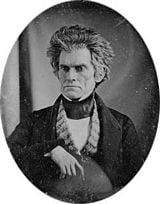
| |
7th Vice President of the United States
| |
| In office March 4, 1825 – December 28, 1832 | |
| President | John Quincy Adams Andrew Jackson |
|---|---|
| Preceded by | Daniel D. Tompkins |
| Succeeded by | Martin Van Buren |
16th United States Secretary of State
| |
| In office April 1, 1844 – March 10, 1845 | |
| President | John Tyler |
| Preceded by | Abel P. Upshur |
| Succeeded by | James Buchanan |
10th United States Secretary of War
| |
| In office October 8, 1817 – March 4, 1825 | |
| President | James Monroe |
| Preceded by | William H. Crawford |
| Succeeded by | James Barbour |
| Born | March 18, 1782 Abbeville, South Carolina |
| Died | March 31, 1850 Washington, D.C. |
| Political party | Democratic-Republican, Democratic, Nullifier |
| Spouse | Floride Bonneau Calhoun |
| Religion | Unitarian |
John Caldwell Calhoun (March 18, 1782 – March 31, 1850) was a leading United States senator, vice president, and political philosopher from South Carolina during the first half of the nineteenth century. Calhoun was an influential spokesman for slavery, nullification, and the rights of electoral minorities, such as slave-holders. His ideas helped lead to the American Civil War a decade after his death.
Calhoun began his career as a staunch nationalist, favoring war with Britain in 1812 and a vast program of internal improvements afterwards. He reversed course in the 1820s to attack nationalism in favor of states rights of the sort Thomas Jefferson had propounded in 1798. Although he died before the Civil War broke out, Calhoun was a major inspiration to the secessionists who created the short-lived Confederate States of America. Nicknamed the "cast-steel man" for his staunch determination to defend the causes in which he believed, Calhoun pushed the theory of nullification, an argument that states could declare null and void any federal law they deemed to be unconstitutional. He was an outspoken proponent of the institution of slavery, which he defended as a "positive good" rather than as a necessary evil. His rhetorical defense of slavery was partially responsible for escalating Southern threats of secession in the face of mounting abolitionist sentiment in the North.
Although best known as a defender of slavery and a Southern partisan, Calhoun was among the nation's most important political theorists. His Disquisition on Government (1849) examined basic principles of sovereignty and personal liberty in the model of Aristotle's Politics or Montesquieu's Spirit of the Laws. It remains one of the most trenchant defenses of limited government and minority interests, while, ironically, providing philosophical justification for the denial of rights of Southern slaves.
Early life
John Calhoun was the son of Scots-Irish American immigrant Patrick Calhoun. When his father became ill, the 14-year-old boy quit school to manage the family farm in South Carolina. But he eventually returned to his studies, earning a degree from Yale College in 1804. After studying law at the Tapping Reeve Law School in Litchfield, Connecticut, Calhoun was admitted to the South Carolina bar in 1807.
In January 1811, Calhoun married his first-cousin-once-removed, Floride Bonneau Colhoun. The couple had ten children over an 18-year period, although three died in infancy. During her husband's second term as Vice President, Floride Calhoun was a central figure in the Petticoat Affair.
Early political career
In 1810, Calhoun was elected to Congress, and became one of the War Hawks who, led by Henry Clay, agitated for what became the War of 1812. After the war, he led a Bonus Bill for public works. With the goal of building a strong nation that could fight a future war, he aggressively pushed for high protective tariffs (to build up industry), a national bank, internal improvements, and many other policies he later repudiated.
In 1817, President James Monroe appointed Calhoun to be Secretary of War, where he served until 1825. His opponents were the "Old Republicans" in Congress, with their Jeffersonian ideology for economy in the federal government; they often attacked the operations and finances of the war department. Calhoun was a reform-minded executive, who attempted to institute centralization and efficiency in the Indian department, but Congress either failed to respond to his reforms or rejected them. Calhoun's frustration with congressional inaction, political rivalries, and ideological differences that dominated the late early republic spurred him to unilaterally create the Bureau of Indian Affairs in 1824.
Vice Presidency
Calhoun originally was a candidate for President in the election of 1824, but decided to become the running mate to both John Quincy Adams and Andrew Jackson. Thus while no candidate received a majority in the Electoral College and the election was ultimately resolved by the House of Representatives, Calhoun was elected Vice President in a landslide.
As his election was separate from that of Adams, who he believed unfairly favored Northern interests, he was not considered part of the administration and the two feuded frequently. In 1828, he ran for reelection as the running mate of Andrew Jackson, and thus became only the second Vice President to serve under two presidents—George Clinton was vice president during the administrations of Thomas Jefferson and James Madison.
Under Andrew Jackson, Calhoun's vice presidency remained controversial. As with Adams, a rift between Northern and Southern views drove a wedge between Calhoun and his president.
The Tariff of 1828, also known as the Tariff of Abominations aggravated the rift between Calhoun and the Jacksonians. He had been assured that Jacksonians would reject the bill, but the Northern Jacksonians were primarily responsible for its passage. Frustrated, he returned to his South Carolina plantation to write South Carolina Exposition and Protest, an essay rejecting the nationalist philosophy he once advocated.
Nullification
He now supported the theory of concurrent majority through the doctrine of nullification—that individual states could override federal legislation they deemed unconstitutional. Nullification traced back to arguments by Thomas Jefferson and James Madison in writing the Kentucky and Virginia Resolutions of 1798, which proposed that states could nullify the Alien and Sedition Acts. Jackson, who supported states rights, but believed that nullification threatened the union, opposed it. The difference, however, between Calhoun's arguments and those of Jefferson and Madison, is that Calhoun explicitly argued for the state's right to secede from the Union if necessary, instead of simply nullifying certain federal legislation.
In 1832, the states rights theory was put to the test in the Nullification Crisis after South Carolina passed an ordinance that claimed to nullify federal tariffs. The tariffs favored Northern manufacturing interests over Southern agricultural concerns, and the South Carolina legislature declared them to be unconstitutional.
In response, Congress passed the Force Bill, which empowered the president to use military power to force states to obey all federal laws, and Jackson sent U.S. Navy warships to Charleston Harbor. South Carolina then nullified the Force Bill. But tensions cooled after both sides agreed to the Compromise of 1833, a proposal by Senator Henry Clay to change the tariff law in a manner which satisfied Calhoun, who by then was in the Senate.
During the Nullification Crisis, President Jackson said in a famous toast, "Our federal Union—it must and shall be preserved." In Vice President Calhoun's toast, he replied, "The Union; next to our liberty most dear!" The irony in this is that Calhoun argued for the Doctrine of Nullification, which had gone as far as to suggest secession, anonymously, making his true opinions unknown to Jackson. The break between Jackson and Calhoun was complete, and, in 1832, Calhoun ran for the Senate rather than remain as Vice President.
Senator and views on slavery
On December 28, 1832, Calhoun accepted election to the United States Senate from his native South Carolina, becoming the first Vice President to resign from office in U.S. history. He would achieve his greatest influence and most lasting fame as a senator.
Calhoun led the pro-slavery faction in the Senate in the 1830s and 1840s, opposing both abolitionism and attempts to limit the expansion of slavery into the western territories. He was also a major advocate of the Fugitive slave act, which enforced the co-operation of Free States in returning escaping slaves.
Calhoun couched his defense of the institution of slavery in terms of (white male) Southerners' liberty and self-determination. And whereas other Southern politicians had excused slavery as a necessary evil, in a famous February 1837 speech on the Senate floor, Calhoun went further, asserting that slavery was a "positive good." He rooted this claim on two grounds—white supremacy and paternalism. All societies, Calhoun claimed, are ruled by an elite group which enjoys the fruits of the labor of a less-privileged group. But unlike in the North and Europe, in which the laboring classes were cast aside to die in poverty by the aristocracy when they became too old or sick to work, in the South slaves were cared for even when no longer useful:
I may say with truth, that in few countries so much is left to the share of the laborer, and so little exacted from him, or where there is more kind attention paid to him in sickness or infirmities of age. Compare his condition with the tenants of the poor houses in the more civilized portions of Europe—look at the sick, and the old and infirm slave, on one hand, in the midst of his family and friends, under the kind superintending care of his master and mistress, and compare it with the forlorn and wretched condition of the pauper in the poorhouse.
Calhoun's fierce defense of slavery and support for the Slave Power played a major role in deepening the growing divide between the Northern and Southern states on this issue, wielding the threat of Southern secession to back slave-state demands.
After a one year break as Secretary of State, Calhoun returned to the Senate in 1845, participating in the epic Senate struggle over the expansion of slavery in the Western states that produced the Compromise of 1850. Even though his health was deteriorating he insisted on protesting the compromise. He died in March 1850, of tuberculosis in Washington, D.C., at the age of 68, and was buried in St. Phillips Churchyard in Charleston, South Carolina.
Legacy
Calhoun's legacy as one of the leading defenders of slavery in American history made him a highly controversial figure. On the other hand his original and articulate argument in defense of minority rights became the legal basis of much of the civil rights movement.
During the Civil War, the Confederate government honored Calhoun on a one-cent postage stamp, which was printed but never officially released.
Calhoun was also honored by his alma mater, Yale University, which named one of its undergraduate residence halls "Calhoun College." (In recent years some students have called for the residence hall to be renamed, either by dropping the name of the slavery defender entirely or by hyphenating Calhoun's name with the name of a civil rights leader. Their efforts have not been successful, but the issue flares periodically.) The university also erected a statue of Calhoun in Harkness Tower, a prominent campus landmark.
ReferencesISBN links support NWE through referral fees
- Bartlett, Irving H. John C. Calhoun: A Biography. New York: W.W. Norton & Co.1993. ISBN 9780393034769
- Calhoun, John C. Papers of John C. Calhoun. Columbia: University of South Carolina Press for the South Caroliniana Society 1959. ISBN 9781570035029
- Calhoun, John C., Ross M. Lence, and John C. Calhoun. Union and Liberty: The Political Philosophy of John C. Calhoun. Indianapolis: Liberty Fund 1992. ISBN 9780865971028
- Coit, Margaret L. John C. Calhoun. Englewood Cliffs, N.J.: Prentice-Hall 1970. ISBN 9780131124097
- Lindsey, David. Andrew Jackson & John C. Calhoun. Woodbury, N.Y.: Barron's Educational Series, 1973. ISBN 9780812004601
- Niven, John. John C. Calhoun and the Price of Union: A Biography. Baton Rouge: Louisiana State University Press, 1988. ISBN 9780807114513
External links
All links retrieved August 3, 2022.
| |||||||
Credits
New World Encyclopedia writers and editors rewrote and completed the Wikipedia article in accordance with New World Encyclopedia standards. This article abides by terms of the Creative Commons CC-by-sa 3.0 License (CC-by-sa), which may be used and disseminated with proper attribution. Credit is due under the terms of this license that can reference both the New World Encyclopedia contributors and the selfless volunteer contributors of the Wikimedia Foundation. To cite this article click here for a list of acceptable citing formats.The history of earlier contributions by wikipedians is accessible to researchers here:
The history of this article since it was imported to New World Encyclopedia:
Note: Some restrictions may apply to use of individual images which are separately licensed.
